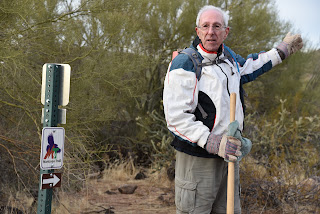2018
WILL BE AN EPIC YEAR FOR THE MARICOPA TRAIL
 |
| Rick Kesselman of the Maricopa Trail + Park Foundation |
Maintaining
and advocating for the Maricopa Trail is a labor of love for Rick
Kesselman, Trail Director and segment steward of the Maricopa Trail+
Park Foundation (MTPF).
The
300+-mile trail that circles the Valley is a work-in-progress and
amazingly, many Arizonans are unaware of this remarkable route and the efforts behind its creation and its exciting future.
I caught up with Rick and a troop
of volunteers on a crisp December morning as they were preparing a
section of the trail that runs between Spur Cross Ranch Conservation
Area and Lake Pleasant Regional Park for the 2018 Prickly Pedal
mountain bike race. This roughly 40-mile mountainous section of the
trail is one of the most technically challenging and visually
appealing for hikers, bikers and equestrians alike making is the
perfect stretch to host the fund-raising event that supports the trail. Kesselman had plenty
to say when I asked why trail users should care about this epic
route.
 |
| New sign installed along the race route on 12-23-17. |
 |
| MT between Spur Cross and Lake Pleasant is visually stunning |
“Its
landscapes, environs, flora and fauna lead trail users to unbounded
outdoor adventures, from myriad unique Sonoran Desert parks and
educational Nature Centers, to healthy trail, mountain, and lake
activities with direct links to scores of welcoming community parks
and trails,” Kesselman said. “These community linkages comprise
the essence of our Foundation's Maricopa Trail Communities Program.
This Program will help focus growth in the Valley's Active Planning
efforts to provide completely linked community trail systems with
each other and the amazingly large Maricopa Trail and County Regional
Parks system. The MT adds a unique treasure for its residents,
visitors and tourists.” Kesselman went on to laude the multi-level
cooperative efforts involved in the trail's overall mission.
“Maricopa County Parks and Recreation Department (MCPRD) and the
Maricopa Trail and Park Foundation feel that it gives communities,
its residents an opportunity to use our facilities. It connects the
ten (soon to be eleven) County parks as well as the individual city
and town trail systems throughout the Valley.
 |
| There are fewer prickly snags thanks to MTPF volunteers |
 |
| Hiking the MT toward Lake Pleasant |
The
“main loop” of the Maricopa Trail is currently 310 miles long,
but future plans will add length and more connectivity to the route.
Much
of the remaining work on the trail will be finished in 2018. “The
main circular loop will be completed in June upon acquisition of
three State Land portions that we have been waiting three years to
acquire. It is currently 99.9% complete,” Kesselman said.
Connectors to Buckeye Hills Regional Park and the future Vulture
Mountain Regional Park are still in the planning stages. Once those
spurs are completed, plans will be drawn up to connect city trail
systems as well.
 |
| MTPF volunteers maintain the route. |
The
latest part of the trail to be completed is the 15.9-mile Segment 22
that runs between McDowell Sonoran Preserve and the Bronco Trailhead
in Tonto National Forest.
 |
| Mountainous terrain defines the Prickly Pedal race course |
On
Jan 20, 2018, up to 350 riders will participate in the third annual
Prickly Pedal Mountain Bike Race, an event that helps support the building and maintenance of the MT. The event is organized by MTPF, a
non-profit organization that works to protect, promote, develop, and
maintain Maricopa County Regional Park trails through sustainable
financial support and volunteer programs. For safety reasons, the race course section of the MT will be closed to all but participants on the day of the event.
 |
| Kesselman instructs trail volunteers |
Those
who wish to contribute or volunteer with MTPF don't need any special
skills to do so.
“ Our
Comprehensive Stewardship Training program trains our Crew Leaders
and Trail Crew volunteers.” Kesselman said. “No previous skills
are necessary. We
also have volunteer opportunities beyond trail work such as
marketing, social media, website administration, fundraising, etc.
Prospective
volunteers can go to the “Events” tab on our website home page to
learn about volunteering opportunities and then to the “Volunteer,
then Stewardship” tab to volunteer."
Maricopa
Trail + Park Foundation
MAPS:
Prickly
Pedal Race



















































